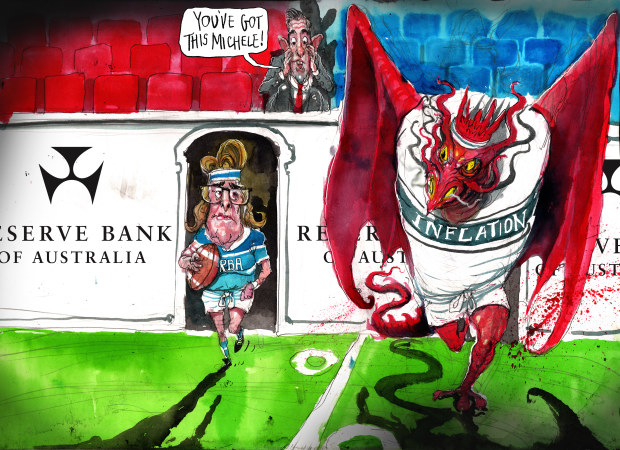Opinion

Albanese fears RBA rate rise fallout - with good reason
The Albanese government knows if rates move again, as now seems inevitable, it’s going to get whacked, regardless of the cause.
Phillip CooreyPolitical editorJim Chalmers played down the significance of Wednesday’s inflation data, saying it was consistent with expectations, and implying the Reserve Bank of Australia had no need to get excited.
“The Reserve Bank looks for material changes in the inflation outlook,” he said.

People are angry and eager to apportion blame. David Rowe
“What we’ve seen today – and they will obviously assess these numbers in their own way – but what we’ve seen today is consistent with our expectations, it doesn’t materially change the inflation outlook going forward.”
They are words that are more about hope than expectation because the Albanese government knows if rates move again, as now seems inevitable, it’s going to get whacked, regardless of the cause.
It’s a far cry from just over six months ago when prime minister Anthony Albanese and Labor made history by winning the seat of Aston in a byelection.
It was the first time in 103 years since a government won a seat from an opposition in a federal byelection.
The victory was all the more impressive given Aston in suburban Melbourne was a mortgage belt seat from central casting, and the country was in the midst of a once-in-a-generation interest rate surge and cost-of-living crisis.
At the time, hardheads from both major parties agreed the voters had yet to blame the government, which was less than a year old, over the rising cost of living.
The war in Ukraine and post-pandemic supply constraints were still foremost in people’s minds.
But both parties knew that would change.
Since Aston, there were two more rates rises – in May and June – and then nothing for the next four months.
Despite economists and the RBA warning way back then there was probably one more increase left, the mood in the electorate increasingly became one that the worst was over. Until Wednesday, that was, when the September quarter inflation data exposed the false dawn by making another rate rise certain and a second one possible.
Among those already hanging on for grim death, the impact will be severe, and it could not come at a worse time – Christmas, the most expensive part of the year. The broader effect on confidence will be significant, as it could be for the government, including a prime minister who blew much of his capital on the Voice referendum.
While the government’s poll numbers are holding up, signs abound of a growing hostility towards it, especially in the suburbs. Some of the No vote on the Voice was motivated by anger that the government appeared not to be focused on bread-and-butter issues.
People are angry and eager to apportion blame.
The quarterly True Issues survey published this week by The Australian Financial Review showed the government’s overall performance rating slipped to an index of 48, the first time it has been below 50 since Labor won the election in May last year.
The cost of living was rated by 81 per cent as the issue on which they wanted the government focussed, followed by daylight, then health, way back on 56 per cent.
There’s a real tinderbox feeling about at the moment.
Introducing your Newsfeed
Follow the topics, people and companies that matter to you.
Find out moreRead More
Latest In Federal
Fetching latest articles